Michigan Boat Bill of Sale Form
A Michigan boat bill of sale is a document proving that selling or buying a watercraft has taken place in the state. Making a deal may be not the only procedure needed to start operating a boat because it may also be required to register the vessel according to state law. Read this article to find out how to go through the registration procedure and whether you need to provide a bill of sale template in this case. If you want to learn how to use bills of sale in other cases, click here for more information.
Michigan bill of sale forms – click for more Michigan-related bill of sale forms that you may need.
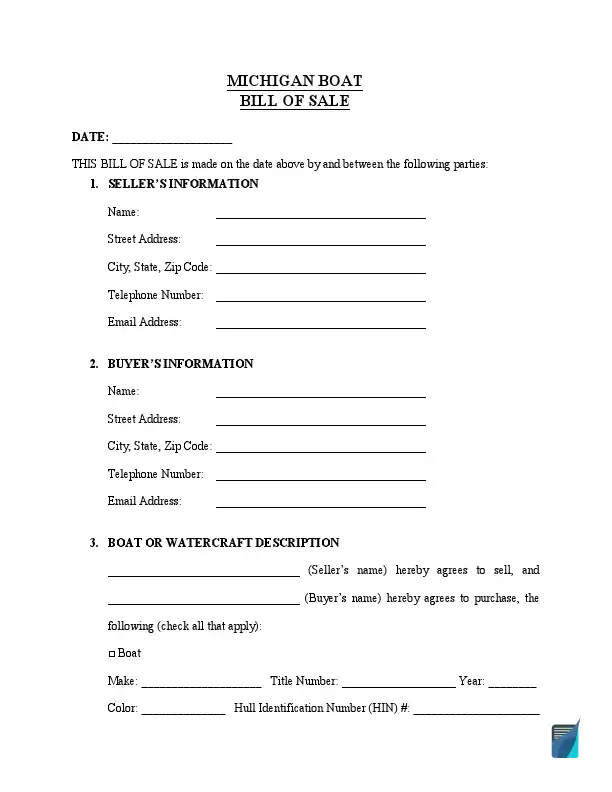
Build Your Document
Answer a few simple questions to make your document in minutes
Save and Print
Save progress and finish on any device, download and print anytime
Sign and Use
Your valid, lawyer-approved document is ready
Do You Have to Register a Watercraft in Michigan?
The question of whether or not you should register your boat in your state should come after you made sure the transaction took place according to the common rules – here is the information that you might need.
While there are a few exceptions, it is generally required to register a boat. You can do it in the Michigan Department of State. A vessel must display a valid registration decal, which cannot be transferred to another boat.
Registration can be conducted in three ways:
- In person
- Online
- By mail
In case it is a not titled watercraft, a buyer can simply complete the back of the watercraft registration for the transfer. If this option is not available, then a Michigan boat bill of sale is needed.
It must include the following information:
- Names of the parties of the deal
- Addresses of the parties of the deal
- The year
- Make
- HIN
- Registration number (if available)
If it is a titled watercraft, then an assigned title is required to transfer ownership. A duplicate of this document can be obtained from any local office of the Secretary of State. You will also need to pay the registration fee, which depends on the length of the boat.
Michigan Boat Bill of Sale Registration Details
| Boat Type | Registration Fees |
| Less than 12 feet and Motorized Canoes | $14 |
| 12 feet to less than 16 feet | $17 |
| 16 feet to less than 21 feet | $42 |
| 21 feet to less than 28 feet | $115 |
| 28 feet to less than 35 feet | $168 |
| 35 feet to less than 42 feet | $244 |
| 42 feet to less than 50 feet | $280 |
| 50 feet or more | $448 |
| Source: Michigan Office of Secretary pf State Recreational Vehicles | |
Where Can You Get a Bill of Sale?
to make sure that all the necessary fields of the bill of sale form are filled out, you should use a printable template provided by the office of the Secretary of State Jocelyn Benson. It is a free form available in PDF format. You can easily fill out the template by navigating from one field to another by using your mouse cursor or the Tab button. It is also possible to use a different template, but in this case, make sure that it contains all the required fields. The bill of sale does not require notarization in this state. However, it must have signatures from both parties of the deal.
Download a Free Michigan Boat Bill of Sale Form
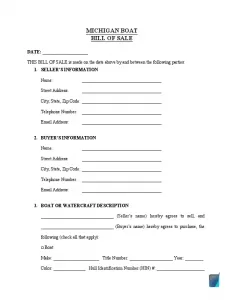
How to write a Michigan Boat Bill of Sale?
The guidelines listed here are based on our sample Michigan boat bill of sale template. Nonetheless, it’s best to opt for the official document should it be provided by the local authorities.
Step 1: Indicate the bill of sale creation date.

Step 2: Provide the details of both parties (seller and purchaser):
- Full name
- Street address
- City of residence
- State of residence
- Zipcode
- Mobile phone number
- Valid email address

Step 3: Fill in the detailed information concerning the watercraft that you’re selling:
- Make (manufacturer)
- Title number
- Year
- Color
- Hull Identification Number
- Odometer reading
- Value
For any inboard/outboard motor that is included in the sale, specify:
- Make
- Horsepower
- Serial Number
- Value
For any trailer that is sold along with the boat, write down:
- Make
- License Plate Number
- Color
- Vehicle Identification Number
- Year of manufacture
- Value
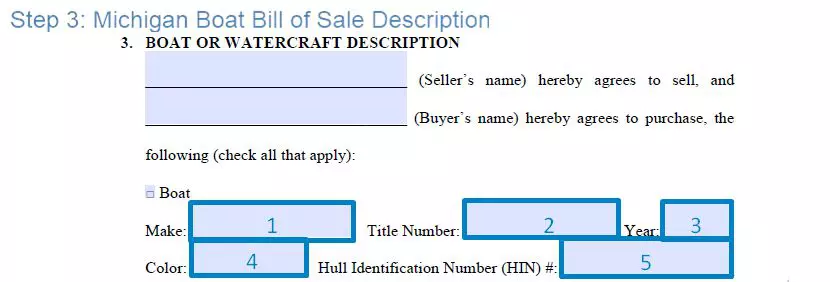
Step 4: Indicate the transaction method and price.
Enter the transaction date and specify the full sum that must be paid for the watercraft. You must furthermore indicate the sale method the purchaser will opt for:
- One-time transaction. This one is pretty easy: the purchaser pays the total price in a single payment and gets the boat transported to them within the same day.
- Boat as a gift. Choosing this option, you indicate that you don’t expect any monetary compensation from the purchaser.
- Installment payments. With this particular method, you have to enter the dates when the purchaser must provide the initial and the last payments, along with their sums.
After that, pick one transaction method:
- Cash
- Cheque
- Cashier’s check
- Money order
Lastly, check whether the purchase price contains all applicable taxes.
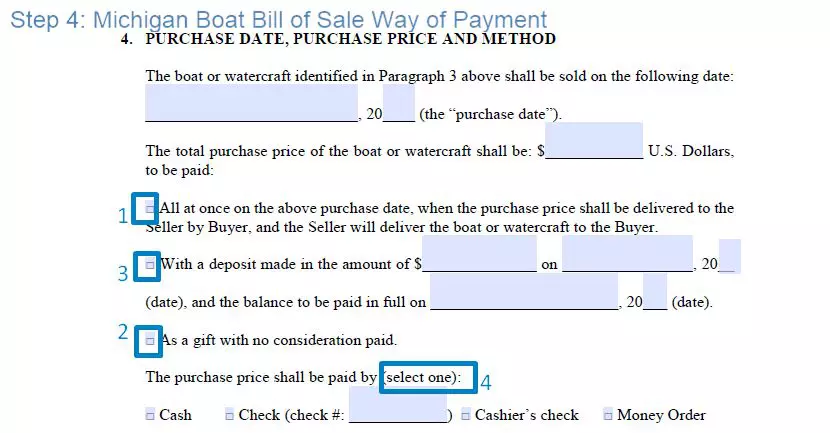
Step 5: Read through standard provisions and make sure all parties are aware of them.
They generally say that the buyer acquires the watercraft in “as-is” condition and is responsible for it once the purchase is finished.

Step 6: Place your signature(s) in the appropriate areas.
The consumer’s signature is typically not required. However, you are more protected against legal problems if all sides sign the document. You may additionally have one or a few witnesses attest the transaction.
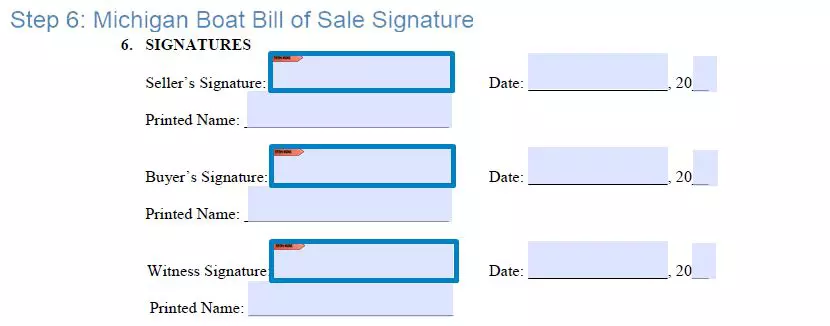
Step 7: Use the help of a notary public
Notarization is normally not needed, but it can be an excellent option to create another level of legal safety to your transaction.
In many states, a bill of sale form might be requested in the course of title change, so the buyer should have the original. As a seller, you can either get a copy and store it or have two identical documents signed and filled out by both sides.
